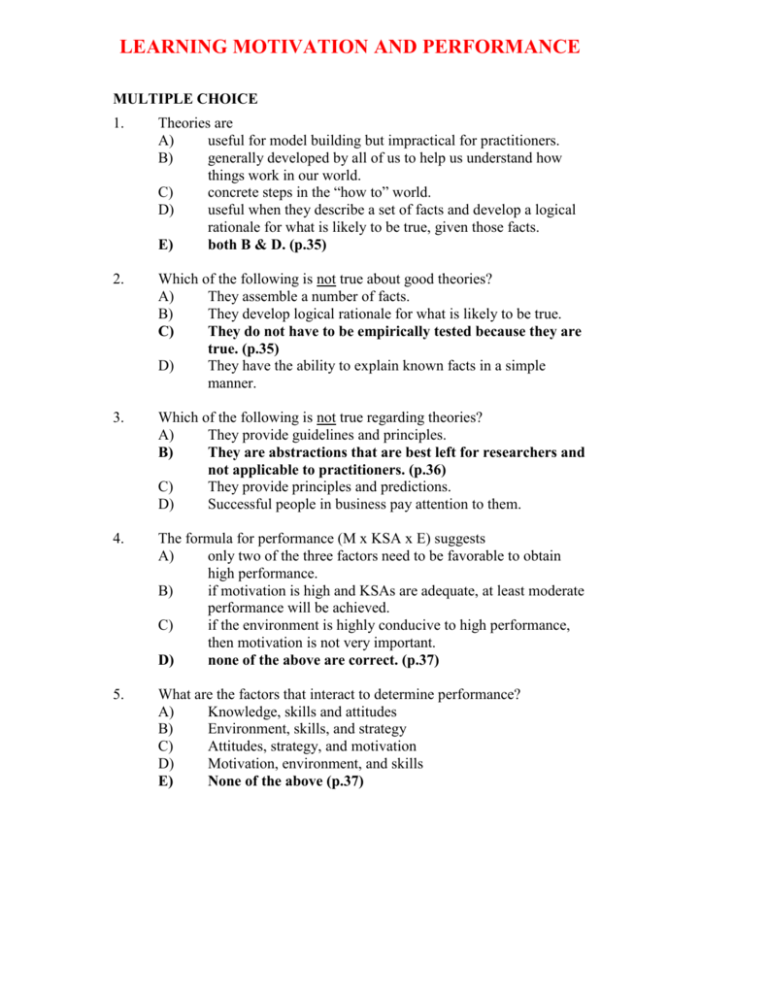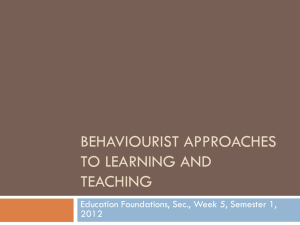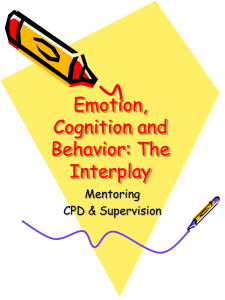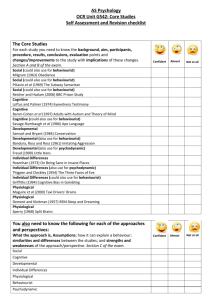learning motivation and performance
advertisement

LEARNING MOTIVATION AND PERFORMANCE MULTIPLE CHOICE 1. Theories are A) useful for model building but impractical for practitioners. B) generally developed by all of us to help us understand how things work in our world. C) concrete steps in the “how to” world. D) useful when they describe a set of facts and develop a logical rationale for what is likely to be true, given those facts. E) both B & D. (p.35) 2. Which of the following is not true about good theories? A) They assemble a number of facts. B) They develop logical rationale for what is likely to be true. C) They do not have to be empirically tested because they are true. (p.35) D) They have the ability to explain known facts in a simple manner. 3. Which of the following is not true regarding theories? A) They provide guidelines and principles. B) They are abstractions that are best left for researchers and not applicable to practitioners. (p.36) C) They provide principles and predictions. D) Successful people in business pay attention to them. 4. The formula for performance (M x KSA x E) suggests A) only two of the three factors need to be favorable to obtain high performance. B) if motivation is high and KSAs are adequate, at least moderate performance will be achieved. C) if the environment is highly conducive to high performance, then motivation is not very important. D) none of the above are correct. (p.37) 5. What are the factors that interact to determine performance? A) Knowledge, skills and attitudes B) Environment, skills, and strategy C) Attitudes, strategy, and motivation D) Motivation, environment, and skills E) None of the above (p.37) 6. According to needs theories which statement is not true? A) Needs are the basis of our motivation. B) Understanding needs helps you understand behaviour. C) Reinforcement theory is a commonly applied needs theory. (p.38-41) D) ERG is an acronym representing three basic needs of a needs theory. E) Maslow and Alderfer are two researchers commonly linked to needs theory. 7. According to Alderfer’s ERG theory A) self-actualization is the highest need. B) the three sets of needs are set up hierarchically and lower levels need to be met before higher order needs. C) the three sets of needs can exist at the same time, a hierarchy is not present. (p.39) D) growth is actually Maslow’s esteem need. 8. In motivating trainees to learn, which of the following needs existence, relatedness, or growth - should be the focus? A) Existence B) Relatedness C) Growth D) Both B & C E) All of the above (p.40) 9. Who used the "law of effect" to develop the operant conditioning model and reinforcement theory? A) Maslow B) Skinner; (easy, p.41) C) Bandura D) Freud E) Vroom 10. Stimulus leads to response which leads to consequence, best illustrates which theory? A) Punishment B) Consequence C) Reinforcement (p.41-42) D) Needs E) Hierarchy of needs 11. Negative reinforcement A) reduces the likelihood of a behaviour. B) increases the likelihood of a behaviour. C) requires removal of something unpleasant. D) both A & C. E) both B & C. (p.42) 12. Which of the following statements is true regarding punishment? A) It does not usually reduce the future likelihood of a behaviour. B) It is a very effective form of motivation. C) Is the same as negative reinforcement. D) It is an undesirable training tool. (p.44) E) Randomly administering punishment keeps trainees on their toes. 13. Which of following statements about expectancy theory is true? A) Expectancy 2 is related to self-efficacy. B) Valence is the measure used for expectancy 1. C) Self efficacy plays a large role in Expectancy 1 (difficult; p.45-49) D) The valence of outcomes is the same for everyone. 14. Which of the following statements is true regarding expectancy theory? A) Expectancy 2 is the likelihood you will receive certain outcomes if you reach acceptable performance. (p.45) B) The values given for outcomes are represented by a value called expectancy 2. C) Expectancy 1 is represented on a scale from 1 to 10 with 1 being the minimum. D) Expectancy 2 is fixed in a person’s mind and is extremely difficult to change. 15. The _____ the self-efficacy, the _____ the performance. A) higher; worse B) higher; better (p.47) C) lower; worse D) lower; better E) all of the above are possible 16. Which of the following statements regarding self-efficacy is not true? A) Physical and emotional state is a factor when estimating an employee's self-efficacy. B) Those with high self-efficacy are also likely to be self-actualized. (challenging; p.47-48) C) The higher the self-efficacy the better the performance. D) Feelings about one's competency are reflected in the concept of self-efficacy. E) Behavioural models can also influence an employee's self-efficacy. 17. Which of the following statements best explains the relationship between training and self-efficacy? A) The two concepts are not related. B) Training can act to improve low self-efficacy only when employees have the required KSAs. C) It is useful to assess trainee self-efficacy prior to training only. D) Self-efficacy beliefs are a good predictor of learning in the training environment. (p.48) 18. Which of the following is not true about studying motivation from a behaviourist approach? A) Accomodation is the process of responding to a stimulus in the environment. (p.49-50) B) It suggests that learning is controlled by the environment. C) It suggests that trainers control learning by controlling the stimuli and consequences that the learner experiences. D) Behaviourists particularly like the definition of learning as a relatively permanent change in behaviour. 19. Which of the following best describes the cognitive approach to training? A) Subject-oriented B) Formal, authority-oriented, judgmental, and competitive C) Interactive, group, project-oriented, and experiential D) Relaxed, mutually trustful, respectful, and collaborative E) Both C & D (challenging; p.50) 20. Social learning theory is A) a behaviourist approach to learning B) demonstrated when a person learns through observation rather than through doing. (p.51) C) where symbolic coding is a stage of the attention process D) demonstrated when a person answers questions before the full question is asked. In social learning theory, retention has three phases which are A) attention, symbolic rehersal, behavioural reproduction. B) recognize, recall, retain. C) attention, motivation, cognitive organization. D) none of the above. (p.51-54) 21. 22. Asking trainees to provide examples of how the training content relates to what they already know facilitates A) Classical conditioning. B) verbal association learning. C) cognitive organization. (challenging; p.53) D) operant conditioning. 23. Symbolic coding is A) the second stage of attracting attention. B) where you rehearse in your mind how to "do it." C) part of the retention process. (p.53) D) a design method for assuring learning. 24. _____ is practicing symbolically and _____ is the transformation of the learning into actual behaviour. A) Symbolic coding; rehearsal behaviour B) Symbolic rehearsal; behavioural reproduction (p.53 C) Symbolic rehearsal; symbolic behaviour D) Cognitive rehearsal; behavioural reproduction E) Cognitive organization; reproduction 25. The Gagne-Briggs theory of instructional design A) has three events: attention, retention, and behavioural reproduction. B) has "gaining attention" as its first event. (p.54) C) is only useful for designing effective lectures. D) both A & B. 26. When there is a major paradigm shift such as moving from hierarchical to consensus decision making, the reason supervisors resist is A) assimilation is required which is very difficult. B) accommodation is required which is very difficult. (p.58) C) supervisors tend to want to always make decisions. D) consensus simply does not work in the North American organization. 27. The power that a group has over its members was first noted in which studies of the 1920's and the 1930's? A) Watson studies B) Hawthorne studies (p.59) C) Pajama factory studies D) Group norm studies 28. The power of the group comes from the group _______ members that follow group norms, or _______ those that do not. A) Punishing; rewarding B) Rewarding; training C) Requesting; training D) Rewarding; punishing (p.59) TRUE AND FALSE 29. 30. 31. 32. 33. 34. 35. 36. ____Performance is a function of motivation times KSAs. (F; p.37) ____ The best way to improve employee performance is to "copy" a successful organization's motivational tactics. (F; p.36) ____Needs theories attempt to describe and explain how a person's needs are translated into actions to satisfy their needs. (F; p.38) ____Relatedness is the middle need in Alderfer’s needs theory. (T; p.38) ____Negative reinforcement reduces the likelihood that a behaviour will be repeated. (F; p.42) ____Punishment is an undesirable management and training tool. (T; p.44) ____Self-efficacy is an important concept in understanding motivation. (T; p.47) ____One of the differences between the behaviourist and cognitive approach to learning is that the cognitive approach is more subject oriented and developed by the instructor. (F; p. 45) SHORT ANSWER QUESTIONS 37. Explain the ERG theory. ERG is an acronym representing the three basic needs of the theory: existence, relatedness, and growth. Existence needs are the needs people have to sustain life, as well as the need to have some security about one's future ability to have a safe and healthy life. Relatedness needs reflect people's needs to be valued and accepted by others. Growth needs include a feeling of self-worth and competency and achieving one's potential. 38. Explain reinforcement theory's contribution to understanding motivation, and explain what other theory is closely related and the foundation of the two theories. Reinforcement theory provides some important answers for how needs are translated into action, but fails to answer other important questions. Reinforcement theory is closely related to the operant conditioning theory of learning. A foundation of reinforcement theory is Thorndike's law of effect which states that behaviour followed by satisfying experiences tends to be repeated, and behaviour followed by annoyance or dissatisfaction tends to be avoided. 39. Compare and contrast accommodation and assimilation with respect to learning and the cognitive theory. Accommodation is the process of changing our construction of the world (cognitive map) to correspond with our experience in it. Assimilation is the incorporation of new experience into existing categories. Therefore, in cognitive map terms, accommodation changes the map whereas assimilation fills in the detail. ESSAY QUESTION 40. Two definitions of learning were presented in the text, one was behavioural and one was cognitive. Explain each and indicate the major difference between these definitions and what the training implications of each are. The behavioural definition of learning is that learning is a relatively permanent change in behaviour. Learning is, therefore, inferred from behaviour. The cognitive approach agrees that learning can be inferred from behaviour but the learning is separate from it. In other words learning can, and does take place prior to the behaviour. In fact, they argue that someone can have learned something and be aware of the new concept for months before exhibiting it behaviourally. Learning for the cognitive theorists is the addition to and reorganization of new knowledge and skills into mental models. So for the cognitive theorists, learning can occur without others knowing it has occurred. Implications for each of the approaches on training are significant in the way training is conducted on a number of levels. First the learner’s role is active and self directed for the cognitive theorists and passive for the behaviourist approach. The instructor’s role is as a facilitator in the cognitive approach and more directive in the behaviourist approach. Training content is problem oriented for the cognitive approach and subject oriented for the behaviourist. Cognitive approach suggests trainee motivation comes from within the trainee, where the behaviourist approach suggests it is external. Training climate is relaxed in the cognitive approach, whereas it is much more formal in the behaviourist approach. The training goals for cognitive theorists are collaborative vs. instructor generated in the behaviourist approach. Finally, the activities are more interactive in the cognitive approach, rather than directive. As can be seen, the two approaches lead to very different ways of designing training.






